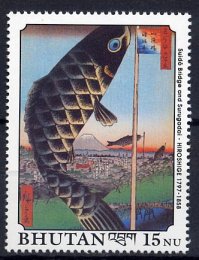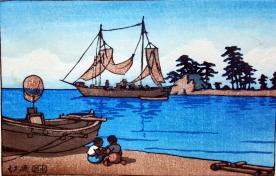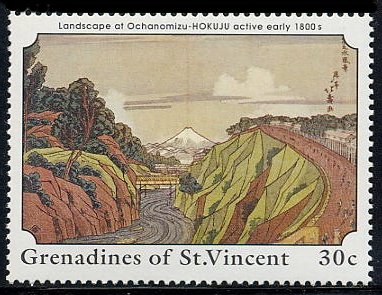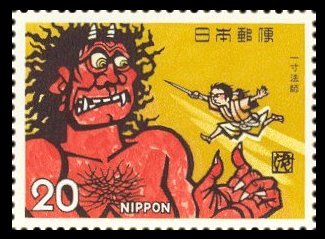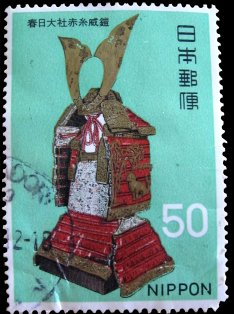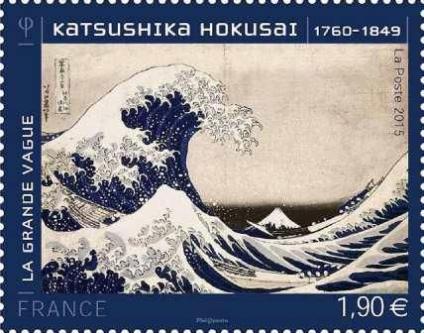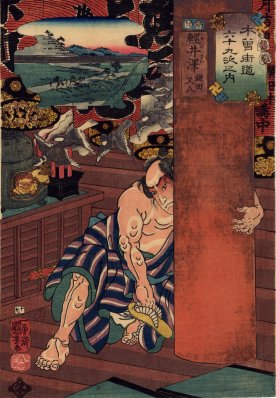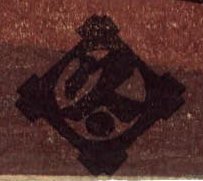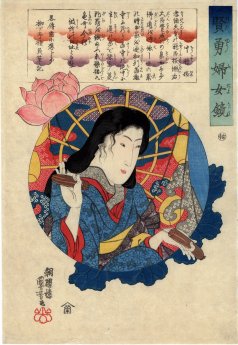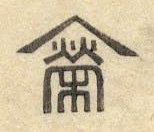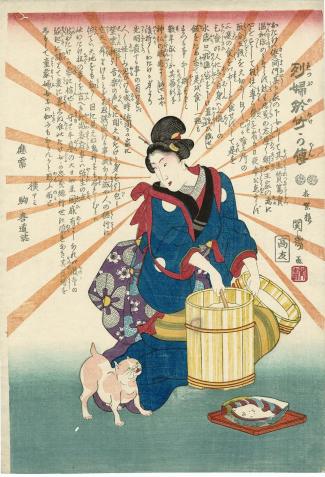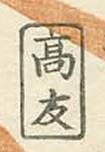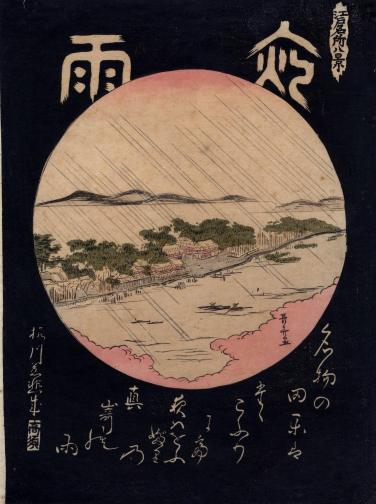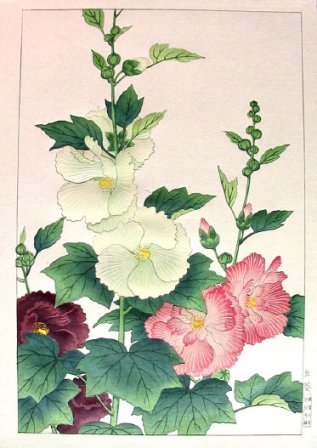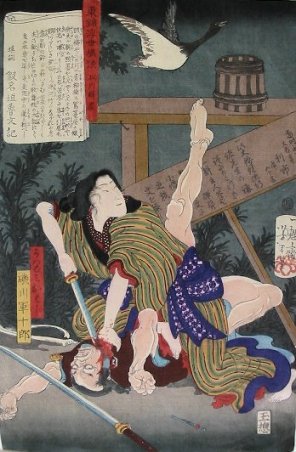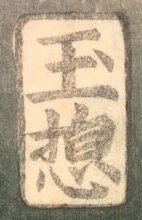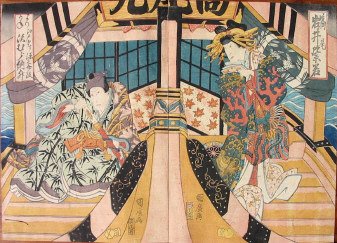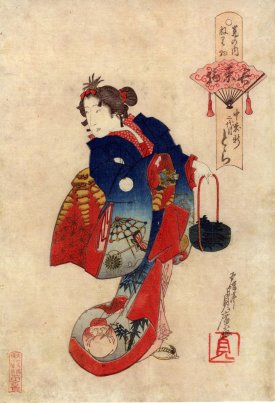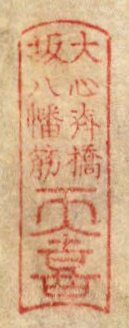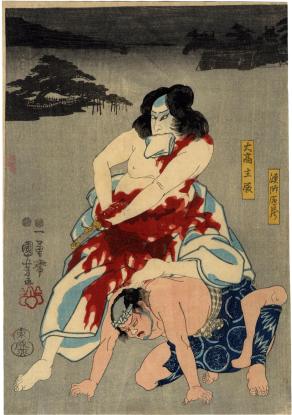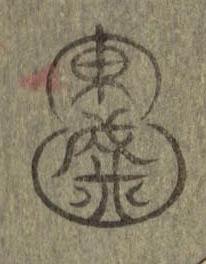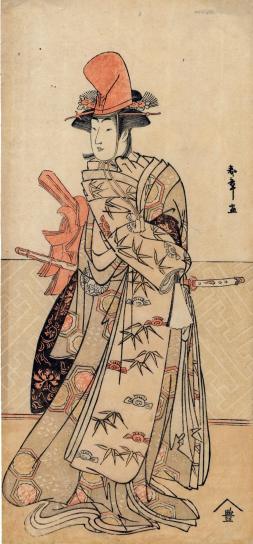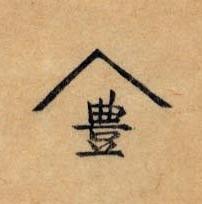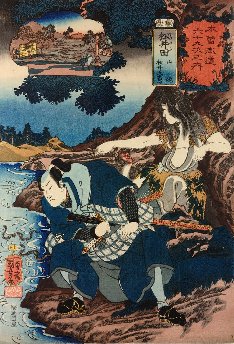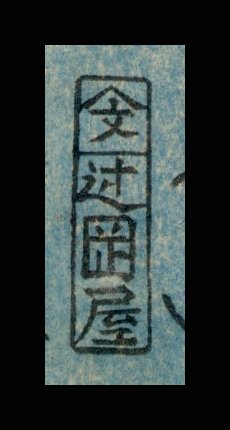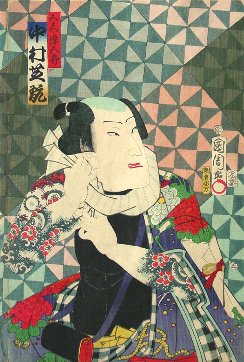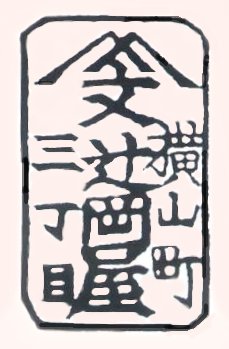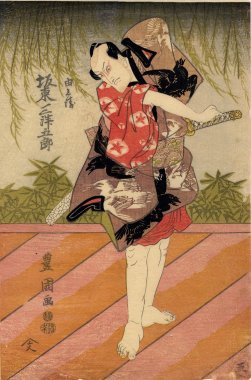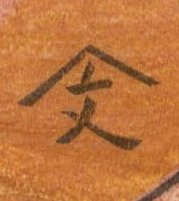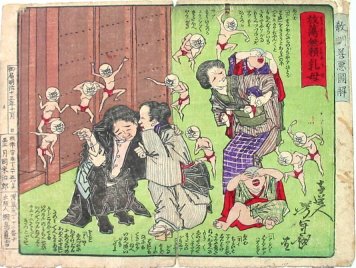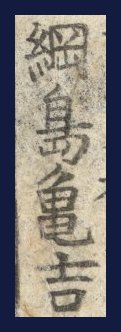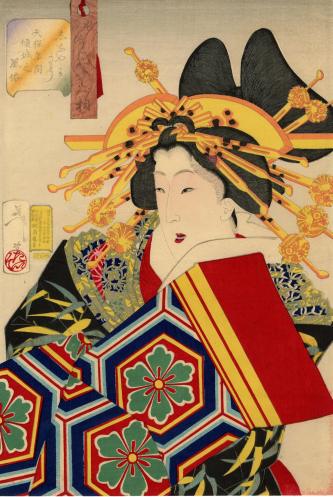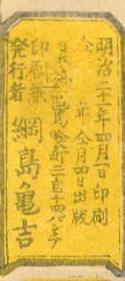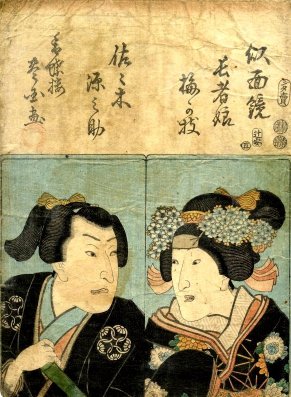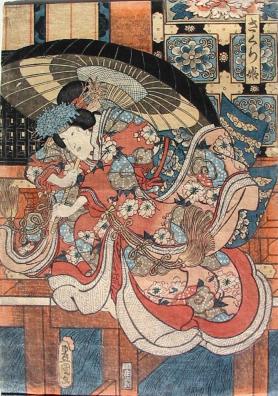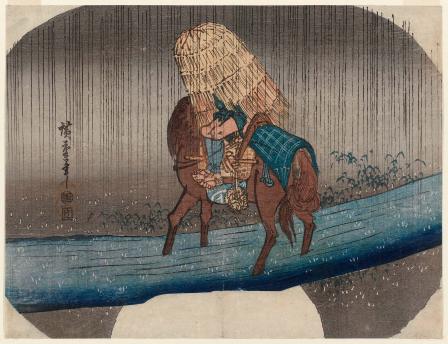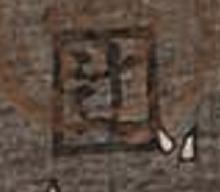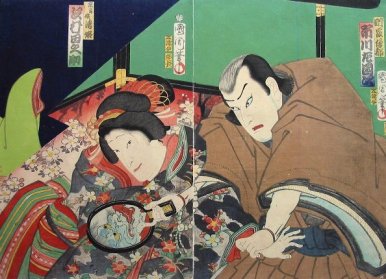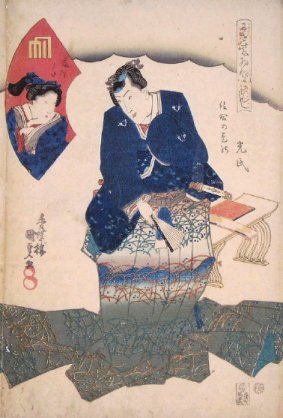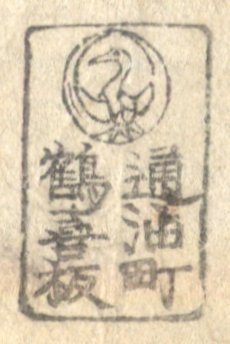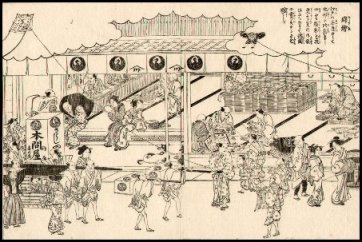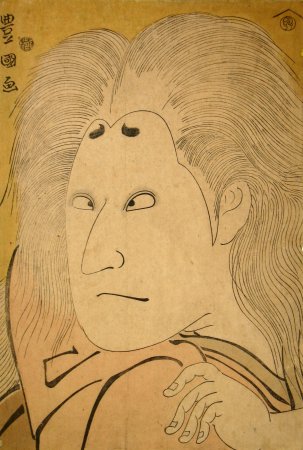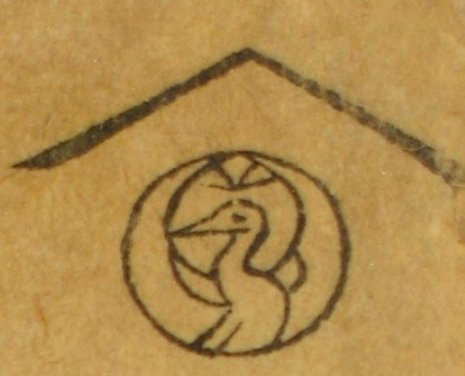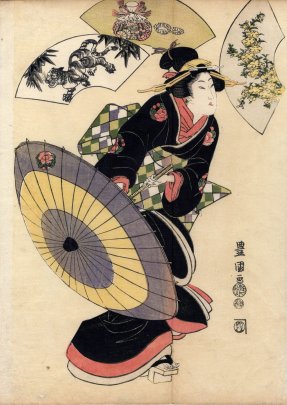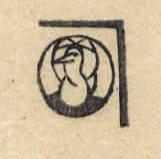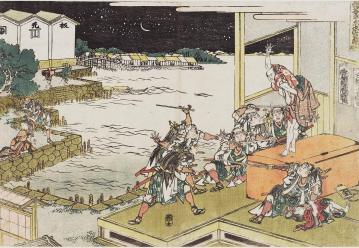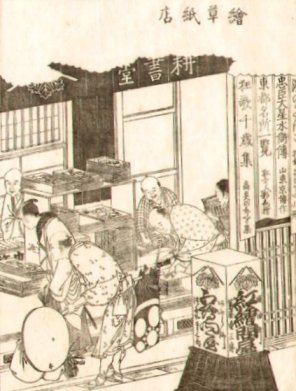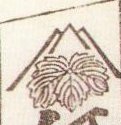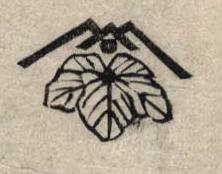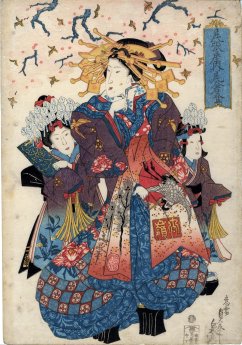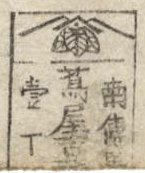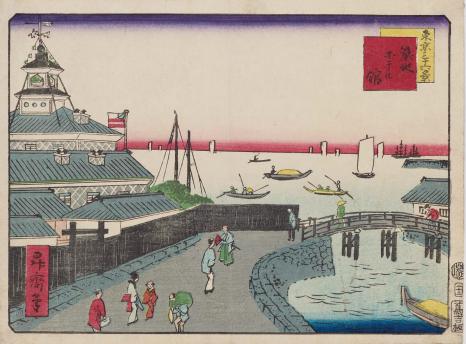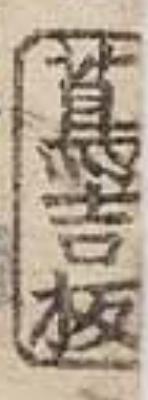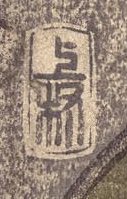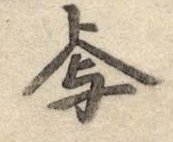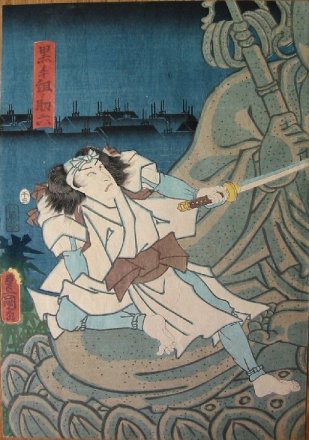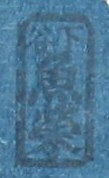
JAPANESE PRINTS
A MILLION QUESTIONS
TWO MILLION MYSTERIES
Ukiyo-e Prints浮世絵版画 |
|
Kansas City, Missouri |
|
PUBLISHERS T to Uoya Eikichi
To go to our other publishers pages click on the stamps below |
||
|
A thru Ebiya |
Echizenya thru G |
H thru Imariya Ushizō |
|
Ise Mago thru J |
K thru Kyōji |
Maruya thru Murataya |
|
N thru S |
Wakasaya to Z |
|
|
CLICK ON THE IMAGES OF THE PRINTS SHOWN BELOW TO SEE LARGER EXAMPLES. |
|
PUBLISHER |
KANJI |
KANA |
LOCATION |
EXAMPLE |
SEAL |
|
ARTISTS |
|||||
|
DATES |
|||||
|
|
|
|
|
|
|
|
Takadaya Takezō (Seal name: Kintake 錦竹) Marks #509
|
高田屋竹蔵 |
たかだや たけぞう |
Edo
The print to the right is from the Lyon Collection. Click on it to go to its full page.
|
Marks seal #07-038 Marks notes that this seal was used between the 1852-1853.
|
|
|
Kuniyoshi, Toyokuni III, Yoshiiku |
|||||
|
Andreas Marks gives the dates as ca. 1851-61 |
|||||
|
Hori Chōsen carved one of the blocks for this publisher's Kuniyoshi Tokaidō series in 1853. Not the one to the far right. |
|||||
|
|
|
|
|
|
|
|
Takahashiya Takakichi (Firm name: Bun'eidō 文栄堂) Marks #512 |
高橋屋高吉 |
たかはしや たかきち |
Edo
The print to the right is from the Lyon Collection. Click on it to go to its full page. |
Marks seal #01-127 Marks notes that this seal
was used
in
1844. restrictive.
|
|
|
Kuniyoshi, Ryūsai Masazumi, Yoshitsuya |
|||||
|
Andreas Marks gives the dates as ca. 1844-47.
However, the in Boston give a slightly longer range - ca. 1843-48. |
|||||
|
|
|
|
|
|
|
|
Takanoya Tomoemon ( Seal name: Takatomo 高友) Marks #515 |
高野屋友右衛門 |
たかのや ともえもん
|
Edo
The print to the right is from the collection of the Museum of Fine Arts, Boston.
Click on it to go to its full page. |
Marks seal #25-206 Marks notes that this seal was used from 1844-55.
|
|
|
Kunimaro, Kuniyoshi, Toyokuni III, Yoshitora |
|||||
|
Andreas Marks gives the dates as ca. 1844-64 |
|||||
|
|
|
|
|
|
|
|
Takasu Sōshichi (Firm name: Fuyōdō 芙蓉堂) Marks #517 |
高須宗七 |
たかす そうしち
|
Edo
The Chōki print to the right is from the Lyon Collection.
Click on it to go to its full page. |
Marks seal #25-203 |
|
|
Chōki, Eishi, Kiyonaga, Shunchō, Toyohiro, Toyokuni I, Utamaro, Utamaro II |
|||||
|
Andreas Marks gives the dates as ca. 1793 to the 1810s. |
|||||
|
|
|
|
|
|
|
|
Takemura Hideo Marks #524 |
竹村秀雄 |
たけむらひでお |
Yokohama |
There is no link to this Hodo print shown above. |
Marks seal #26-155 |
|
Hodo & Kōitsu |
|||||
|
Andreas Marks gives the dates as ca. 1926-1939 |
|||||
|
|
|
|
|
|
|
|
Tamaya Sōsuke (Seal name: Tamasō 玉惣) Marks #528 |
玉屋 惣助 |
たまや そうすけ |
Edo/Tokyo |
Marks seal #25-145 Marks notes that this seal was used in 1849. This does not agree with the date of the print to the left which is from 1868. |
|
|
Kuniyoshi, Toyokuni III, Yoshifuji, Yoshiiku, Yoshikazu, Yoshitoshi |
|||||
|
Andreas Marks gives the dates as ca. 1847-68 |
|||||
|
|
|
|
|
|
|
|
Tamura Tetsujirō Marks #531 |
田村鉄治郎 |
たむら てつじろう |
Tokyo
The image to the right is from the Lyon Collection.
Click on the image to see more information. |
Marks seal #26-120 |
|
|
Chikashige, Kunichika |
|||||
|
Andreas Marks gives the dates as ca. 1876-78. |
|||||
|
|
|
|
|
|
|
|
Tenmaya Kihei (Seal name: Tenki 天喜; firm name Kinkadō 金華堂 Marks #536 |
天喜 or 天満屋喜兵衛 |
てんき or てんまや きへい |
Osaka |
Marks seal #26-155 Marks notes that this seal was used between 1826-1838. |
|
|
Ashiyuki, Hironobu, Hirosada, Hokucho, Hokuei, Hokusetsu, Hokushū, Kiyokuni, Kunhiro, Nobuharu, Nobuhiro, Nobukatsu, Nobumasa, Sadahiro, Sadamasu, Sadanobu, Sadayoshi, Shibakuni, Shigeharu, Shigenao, Toshikuni, Toyohide, Umekuni, Yoshikuni |
|||||
|
Andreas Marks gives the dates as ca. 1816-60 |
|||||
|
Izutsuya Denbei's seal appeared along with that of Tenmaya Kihei on a Yoshikuni diptych in 1825. |
|||||
|
|
|
|
The image to the right is from the Lyon Collection.
Click on the image to see more information.
|
|
Marks seal #24-035 Marks notes that this seal was used in 1836. |
|
|
|
|
|
|
|
|
Tōseidō Marks #U345 |
東盛堂 |
とうせいどう |
Edo
The image to the right is from the Lyon Collection.
Click on the image to see more information. |
Marks seal #12-043 |
|
|
Gengyo, Kuniyoshi, Shigemitsu |
|||||
|
Andreas Marks gives the dates as ca. 1847-50. |
|||||
|
|
|
|
|
|
|
|
Toshikuraya Shinbei formerly referred to as Toshin (aka Tokuraya Shinbei) Marks #539 (Seal name - Rishin/Toshishin 利新) |
利倉屋新兵衛 |
としくらや しんべえ |
Osaka
One more point: This Hokushū print is often shown without any publisher's seal.
The image to the right is from the Lyon Collection.
Click on the image to see more information.
|
Marks seal #25-553 Marks notes that this seal was used between 1821-1823. |
|
|
Ashihiro, Ashikuni, Ashiyuki, Chikakuni, Hashikuni, Hikokuni, Hokuchu, Hokusei, Hokuyō, Hokushū, Kunihiro, Kuninao, Shibakuni, Shigeharu, Shigenobu, Shuncho, Shunkō, Shunei, Shunshi, Tamikuni, Utakuni, Yoshikuni |
|||||
|
Andreas Marks gives the dates as ca. 1815-38 |
|||||
|
Toshikuraya Shinbei was also known to have published with Ariwaradō Chūbei in 1819, at least. |
|||||
|
|
|
|
|
|
|
|
Toyoshimaya Bunjiemon (Seal name: Toshimaya 冨嶋屋; firm name Bukindō 文錦堂; familly name Ōbatake Bunjiemon 大畠文治右衛門) Marks #543 |
豊嶋屋文治右衛門 |
とよしまやぶんじえもん |
Nagasaki
The Shunshō print to the right is from the Lyon Collection.
Click on the image to see more information.
|
Marks seal #01-109 Marks notes that this seal was used between 1786-91. |
|
|
Shunkō, Shunshō |
|||||
|
Andreas Marks gives the dates as 1750s to ca, 1859. |
|||||
|
|
|||||
|
Tsujiokaya Bunsuke (Seal name - Tsujibun 辻文; firm name - Kinshōdō 金松堂; family name - Tsujioka Bunsuke 辻岡文助) Marks #548 |
辻岡屋文助 |
つじおかや |
Edo |
There is no internal link to this Kuniyoshi print shown above.
However, if you want to see more information about this image click on the print to see what it says about the print in the Lyon Collection. |
Marks seal #21-228 |
|
Eitaku, Fujiyoshi, Fusatane, Ginkō, Hirokage, Hiroshige II, Hiroshige III, Kuniaki II, Kunichika, Kunihisa II, Kunisada II, Kunisato, Kunitaka, Kuniteru, Kuniteru II, Kuniyasu, Kuniyoshi, Kyōsai, Nobukazu, Sadahide, Toshihide,
Toyokuni I, Yoshifuji, Yoshiharu, Yoshiharu II, Yoshiiku, Yoshikazu, Yoshimitsu, Yoshimune, Yoshitoshi, Yoshitoyo, Yoshitsuya |
|||||
|
Andreas Marks gives the dates of ca. 1814 to ca. 1896 |
|||||
|
The carver Hori Gin worked
for this publisher, as did Hori Take in 1852. Hori Mino worked for them in 1852. Hori Kane worked for this house in 1858 on Yoshitsuya prints. |
|||||
|
"Tsujiokaya Bunsuke published actor prints by Toyokuni beginning around 1814. His output decreased significantly during the late 1820s and early 1830s. In the late 1830s and early 1840s, he picked up again and became more active by issuing some minor series of Kuniyoshi and Kunisada respectively. But it was not until the late 1840s when Tsujiokaya's business finally boomed through issuing Kunisada's actor prints." In the fourth month of 1852 he took over the publishing firm of Tsuru-ya Kiemon. (See that listing below.) In the mid-1850s Tsujioka started publishing illustrated books and in time this became a more important factor than the production of prints. Source and quotes from Japanese Woodblock Prints: Artists, Publishers and Masterworks 1680-1900 by Andreas Marks, p. 262. |
|||||
|
|
|
|
The print shown to the right is not one we have offered. The image has been sent to us from the Eikei (英渓) Collection. We are grateful for this contribution to our site |
This example comes from a different print than the one being shown.
Marks seal #23-066 |
|
|
|
|
|
The print to the right is from the Lyon Collection. Click on it to go to its full page.
|
Marks seal #01-107
Marks notes that this seal was used between 1814-1852. |
|
|
|
|
|
|
|
|
|
Tsujiokaya Kamekichi (Seal name - Tsujikame 辻亀; seal names - Kinkidō 錦亀堂, Tōsendō 島鮮堂; family name - Tsunajima Kamekichi 綱島亀吉) Marks #549 |
綱島亀吉 |
つなじま かめきち |
Edo/Tokyo |
|
|
|
Beisaku, Chikanobu, Chikashige, Eitaku, Fusatane, Ginkō, Hiroshige III, Kunichika, Kunimatsu, Kunisada III, Kuniteru, Nobukazu, Seisai, Shigekiyo, Toyokuni III, Toyonobu, Yoshiiku, Yoshitora, Yoshitoshi, Yoshitora, Yūsai Toshiaki |
|||||
|
Andreas Marks gives the dates of ca. 1866 to 1918. |
|||||
|
|
|
|
The print shown to the right is from the Lyon Collection. Click on it to see the full page devoted to this print. |
|
|
|
|
|
|
|
|
|
|
Tsujiya Yasubei (Seal name - Tsujibun 辻安; firm name - Kinkaidō 錦魁堂) Marks #550 |
辻屋安兵衛 |
つじや やすべい |
Edo
The print shown to the right is not one we have offered. However, it has a publisher's seal which we want to display for your information. The image was sent to us from our contributor ED. We are grateful for this addition to our site. |
Marks seal #25-418
Marks notes that this seal was used between 1842-1861.
|
|
|
Shinsai Eishō, Fusatane, Hiroshige, Hiroshige II, Kunichka, Kunihisa II, Kunimori, Kunimori II, as Kunisada & Toyokuni III, Kuniyoshi, Hōrai Shunshō, Yoshitora, Yoshitsuna |
|||||
|
Andreas Marks gives the dates of ca. 1842 to 1/1863.
|
|||||
|
The carver Hori Shōji worked
|
|||||
|
|
|
|
The print to the right is the top half of a vertical diptych. To see the whole thing, click on it. |
Unlisted in Marks |
|
|
|
|
|
The print to the
right is Boston. Click on it to see more information. |
Unlisted in Marks |
|
|
|
|
|
|
|
|
|
|
|
|
|
|
|
|
Tsunokuniya Isaburō Marks #552 (Seal name - Tsurnoi 津ノ伊) |
津伊 (津國屋 伊三郎) |
つのい (つくにや いさぶろう) |
Edo /Tokyo |
Marks seal #21-188
|
|
|
Kunichika & Yoshitoshi |
|||||
|
Andreas Marks gives the years ca. 1857-1869. |
|||||
|
The carver Hori Chō
worked on blocks for Kunichika for this publisher in 1868
as did also worked for this house. |
|||||
|
There is a print in the Museum of Fine Arts, Boston from 1869 on which both Kunichika and Yoshitoshi collaborated. |
|||||
|
|
|
|
|
|
|
|
Tsuruya Kiemon (Seal name - Tsuruki 鶴喜; firm name - Senkakudō 僊鶴堂; family name - Kobayashi Kiemon 小林喜右衛門) Marks #553 |
鶴屋喜右衛門 |
つるや きえもん |
Edo/Tokyo
The print shown to the right is not one we have offered. However, it has a publisher's seal which we want to display for your information. The image has been sent to us from the Eikei (英渓) Collection. We are grateful for this contribution to our site |
Marks seal #22-066
Marks dates this seal from the 1820s to 1841. |
|
|
Chōki (b), Eisen (b), Eizan (b), Harunobu, Hiroshige (b), Hokusai (b), Kiyoharu, Kiyomasa, Kiyomasa II, Kiyomasu II, Kiyomine, Kiyomitsu I, Kiyomitsu II,
Kiyonaga ( Kiyonobu II,
Kunisada, Kunimasa,
Kuniyasu (b), Kuniyoshi, possibly Kyōsai, Masanobu (b),
Masayoshi ( Sadafusa, Sadahide (b), Sadakage (b), Sadatsuna, Senchō (b),
Shunchō,
Shun'ei,
Shunshō, Shunsui,
Shuntei ( Sudatora, Toyokuni I (b), Toyoshige (b), Toyonobu, Utamaro, Utamaro II, Yasuhide (b) possibly Yoshiiku,
A (b) means as a book illustrator sometimes along with woodblock prints. |
|||||
|
As early as the 1620s or earlier to as late as 1852. Again in ca. 1870 to 1898. |
|||||
|
Andreas Marks in his Japanese Woodblock Prints: Artists, Publishers and Masterworks 1680-1900 (p. 190) tells us that this firm was one of the longeset lasting. They started out printing books. "In the 1670s, he published the first picture albums by Moronobu." In 1807 Tsuruya published the first prints by Kunisada. That was the same year the firm was part of the Picture Book and Print Publishers Guild and the Book Publishers Guild. "In 1811 and 1813, Tsuruya functioned as gyōji (censor) for the guild, following regulations by the government that attempted to control the market better." The most successful book they ever printed was the so-called 'Country Genji' authored by Ryūtei Tanehiko and illustrated by Kunisada. However, its success also got them into trouble with the authorities. Tsuruya "...was not able to recover from the complications with the 'Country Genji' and his business was taken over by fellow publisher Tsujiokaya Bunsuke in the fourth month of 1852. From this point on there are no more prints by Tsuruya, but books appear again starting around 1870 by Tsuruya Kiemon. In which way this Tsuruya is related to the previous is unclear."
In the 1830s Tsutaya Kichizō co-published a series of Kuniyoshi landscape prints with Tsuruya Kiemon. Both of their seals appear on each of these prints. Nishimuraya Yohachi collaborated with Tsuruya Kiemon and Jōshuya Jūzō on a Hokusai suguroku print in the 1820s. |
|||||
|
|
|
|
An anonymous contributor has sent us this book illustration by Hasegawa Settan which shows the front and interior of the shop of Tsuru-ya Kiemon.
Click on the image ot see a page with a larger detail. |
This is not the publisher's seal, but rather one of their logos. |
|
|
|
|
|
The image to the right by Toyokuni I gives and alternate seal which we have not offered yet. This was contributed to this site by my friend Mike.
Click on the image to see a page with a larger detail. |
|
|
|
|
|
|
|
|
|
|
Tsuruya Kinsuke (Seal name - Tsurukin 鶴; firm name - Sōkakudō 雙鶴堂;
family name - Iijima Kinsuke
Marks #554
|
鶴屋金助
|
つるや きんすけ |
The image to the right by Toyokuni I is from the Lyon Collection. Click on it to learn more.
|
Marks seal #06-002
This seal was used throughout the existence of this publishing house. |
|
|
Eisen, Eizan, Hokusai (b), Kunihisa,
Kunimitsu (b),
Kuninao (
Kuninobu (b),
Kunisada (
Shuntei, Toyohiro, Toyokuni I, Toyokuni II, Tsukimaro (b), Utamaro, Utamaro II,
A (b) means as a book illustrator sometimes along with woodblock prints. |
|||||
|
Andreas Marks gives the dates of ca. 1797 to 1824
We have a question: Mark gives the last date for this publisher as 1824. But Toyokuni I didn't die until 1825. Then how could this house have been the publisher of works by Toyokuni II? |
|||||
|
|
|
|
The image to the right by Hokusai is in the collection of the Museum of Fine Arts, Boston. |
|
Marks seal #21-083
This seal was used in 1806 |
|
|
|
|
|
|
|
|
Tsutaya Jūzaburō (Seal name - Tsutajū 蔦重, firm name - Kōshodō 耕書堂; family name - Kitagawa Jūzaburō 喜多川重三郎) Marks #555 |
蔦屋重三郎 |
つたやじゅうざぶろう |
Edo
The print shown to the right is not one we have offered. An anonymous correspondent has been kind enough to let us display it.
It shows the interior of Tsutaya's shop as it appeared in 1799 in the Ehon azuma asobi or 'Picture Book of the Pleasure Sports of the Eastern Capital' illustrated by Hokusai.
(This is from information provided by Andreas Marks.) |
Marks seal closest to #03-001 |
|
|
Chōki (b), Eisen, Eizan, Eishi, Fusanobu, Harumachi, Hidemaro, Hiroshige, Hokuba, as both Sori & Hokusai, Kiyomasa, Kiyomitsu,
Kiyonaga (
Koryūsai,
Kunimaru (
Kunimitsu (b), as both Kunisada & Toyokuni III, Kunimasa, Kuniyasu, Kuniyoshi, Masanobu (b),
Masayoshi (
Sharaku,
Shigemasa (
Shikō, Shunchō, Shun'ei, Shunman,
Shunshō (
Suzuki Rinshō, Tōrin III
Toyokuni I (
Toyokuni II, Tsukimaro (b), Utamaro (b),
A (b) means as a book illustrator sometimes along with woodblock prints. |
|||||
|
Started publishing in 1774 and continued to as late as 1847-52 or later (This last date is from a seal found on a Toyokuni III triptych in the Boston MFA.)
There is a Kunisada triptych in the Museum of Fine Arts, Boston that shows the publisher seals of both this house and that of Enomotoya Kichibei. One additional complicating factor is that both Tsutaya Jūzaburō and Tsutaya Kichizō used almost the same seal. These are not easily distinguishable. |
|||||
|
"Tsuta-ya Jūzaburō is notable for having established a commanding and innovative presence in the Edo publishing world. He... is credited with 'the gift of discovering genius', particularly that of Utamaro. At various times he offered lodgings to Kyokutei Bakin, Santō Kyōden and Utamaro.... Tsuta-ya Jūzaburō... was born in the Yoshiwara pleasure quarter in 1750. [He died in 1797.] In 1773 opened a bookshop at the entrance to the quarter selling the guidebooks, or Yoshiwara saiken, published by the firm of Urokogataya Magobee, which had been in business since 1660. The following year he launched his career as a publisher with a courtesan critique, and in 1775 he produced his own guide to the Yoshiwara. In doing so he was probably taking advantage of the fact that Urokogataya Magobee was at the time beset by problems connected with a copyright infringement case..." For years Tsutajū competed head to head with Urokogataya for the Yoshiwara saiken market. Urokogataya lingered on until 1803 when they ceased publishing. "Well before this, however, he had begun to branch out, employing artists such as Katsukawa Shunshō to illustrate his guidebooks, and from 1776, publishing illustrated books on haikai poetry, ehon and sharebon." In 1783 he moved away from the Yoshiwara to a larger and permanent home.
In the 1780s he published poetry and light fiction, but in 1791 the new conservative government came down hard on him. "In that year, he published three of Santō Kyōden's sharebon. These were subsequently made an example of by the new régime in power... with the result that not only was Kyōden punished but also Tsutajū, who had gone through the correct procedures to gain permission to publish, had half his wealth confiscated, and the gyōji, or guild officials, were banished from Edo." After this Tsutajū left the guild he was working with and "...joined the guild of 'serious books'." Supposedly he did this more for financial reasons - he could now raise new capital to replace some of what he had been fined - than to clean up his act. "...the main focus of his activity in the early 1790s was actually not 'serious' publishing, but single sheet ukiyoe prints of beauties and actors by Utamaro, Sharaku and others." In 1794 he bought up the blocks for some illustrated books published by others, moved their seals and put his own on them. In 1796 he came out with his own new original publication in this field. "Although the firm survived for some years under the chief clerk, it lacked the entrepreneurial energy that had propelled it from obscurity..."
Source and quotes from: The Book in Japan: A Cultural History from the Beginnings to the Nineteenth Century by Peter Kornicki.
Andreas Marks in his Japanese Woodblock Prints: Artists, Publishers and Masterworks 1680-1900 (p. 204) says: Tsutaya Jūzaburō is probably the best known publisher today, mainly because of his forerunner position and connection to Utamaro and Sharaku." The first artist he published was Shigemasa in 1774. "In 1775, or perhaps already in 1774, Tsutaya joined the publisher Urokogataya in regularly issuing the 'Guide to the Yoshiwara' (Yoshiwara saiken). In fall of 1776, Tsutaya took over and continued these guides on a regular basis until 1836." In 1783 he took over the business of Maru-ya Kohei. This was also the first year he published works by Utamaro. After Jūzaburō I died in 1797 his chief clerk Yūsuke took over and continued the business operations the way they had been. He also adopted the name Jūzaburō II. Marks adds that "After the 1810s, only a very few publications appeared." In 1807 Tsutaya was listed as a member of the Picture Book and Print Publishers Guild and the Book Publishers Guild. The head of the firm acted as a print censor in 1811, 1812 and again in 1813. "In 1833 Jūzaburō II passed away and shortly thereafter, in 1837, Jūzaburō III died. The business was continued by Jūzaburō IV..." In 1852 it was taken over by Yamada Shōjirō. [That firm is listed further down this page.]
Tsutaya Jūzaburō's seal is an ivy leaf befow the three peaks of Mt. Fuji.
|
|||||
|
|
|
|
|
|
|
|
Tsutaya Kichizō (Seal name - Tsutakichi 蔦吉; firm name - Kōeidō 紅栄堂; family name - Hayashi Kichizō 林吉蔵) Marks #556 |
蔦屋吉蔵 |
つたや |
Edo/ Tokyo
The Toyokuni I print to the right is from the Lyon Collection. |
|
Marks seal #03-004 Marks notes that this seal was used between the 1820s-1861.
|
|
Chikanobu, Eisai, Eisen (b), Ginkō, Hiroshige, Hiroshige II, Hiroshige III, Ikkei, Kagematsu (b), Kunichika, Kunimaro (b), Kunisada (b), Kunisada II, Kunisada III, Kunikiyo, Kunitama, Kuniteru, Kuniyasu, Kuniyoshi, Rinsai, Sadahide (b), Sadatora, Senchō (b), Shosai, Sūgakudō, Toshinobu, Toyokuni III (b), Yoshiharu II,
Yoshitora, Yoshitoshi, Yoshitsuna, Yoshitsuru I, Yoshitsuya
A (b) means as a book illustrator sometimes along with woodblock prints. |
|||||
|
Andreas Marks gives the dates of ca. 1820 to 1890 |
|||||
|
The carver Hori Gin worked
and 1853-54 and 1865. Hori Sen in 1852. |
|||||
|
There are Hiroshige prints in the Museum of Fine Arts in Boston published by Jōshūya Jūzō that were originally published by Tsutaya Kichizō. In the 1830s Tsutaya Kichizō co-published a series of Kuniyoshi landscape prints with Tsuruya Kiemon. Both of their seals appear on each of these prints. |
|||||
|
|
|
|
The print to the right is from the Lyon Collection. Click on it to go to its full page.
|
Marks seal #23-059. It was used between 1832-36. |
|
|
|
|
|
The print to the right is from the Museum of Fine Arts, Boston. Click on it to go to its full page.
|
This seal is closest to Marks seal #25-427. It was used between 1860-67. |
|
|
|
|
|
|
|
|
|
Uemura Yohei (seal names - Uemura 上村 and Ueyo 上与) Marks #564 |
上村与兵衛 |
うえむら よへえ |
Edo
The print is shown courtesy of my friend Mike. I am truly grateful.
Click on the image to see a page with a larger detail. |
Marks seal #25-297 Marks notes that this seal was used in 1796 and 1810.
|
|
|
Eisen, Kiyonobu II, Kunimaru, Kunimasa, Kunisada, Kunitora, Kuniyasu, Kuniyoshi, Shun'ei, Tsukimaro, Toyokuni I, Utamaro |
|||||
|
Andreas Marks gives the dates of ca. 1750s to 1832 |
|||||
|
|
|
|
Edo
The print to the right is from the Lyon Collection. Click on it to go to its full page.
|
Marks seal #05-007 Marks notes that this seal was used between the 1813-1832. |
|
|
|
|
|
|
|
|
|
Uoya Eikichi 2 variants shown Marks #442 (Marks says this is an erroneous misattribution based on an incorrect reading of this name. It should be Sakanaya Eikichi. See that entry on our N thru S publishers page.) |
魚屋栄吉 |
うおや |
Edo |
There is no link to the Toyokuni III print shown above. |
|
|
Hiroshige, Hiroshige II, Kunisada II, Toyokuni III, Yoshimori |
|||||
|
As early as 1855 or earlier to as late as 1866 according to Andreas Marks. |
|||||
|
Hori Take carved for them from 1857-59. |
|||||
|
|
|
|
|
There is no longer a link to the print shown above. |
|
|
|
|
|
|
|
|
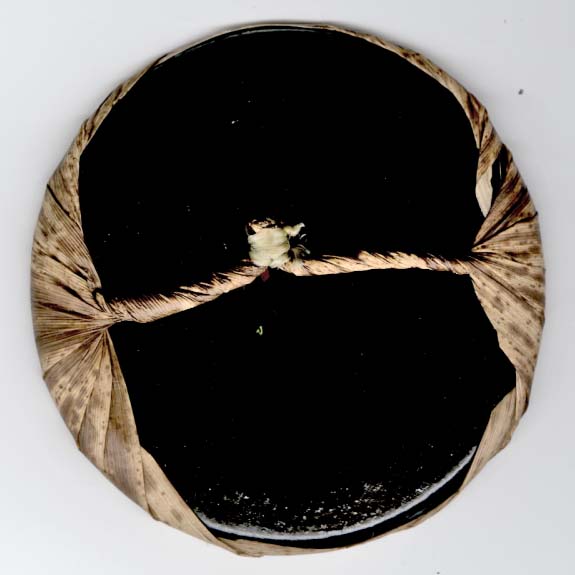 |
||||
|
CLICK ON THE BACK OF THE BAREN SHOWN ABOVE TO GO TO FIRST PUBLISHERS PAGE WHERE THEY ARE ARRANGED ACCORDING TO SHAPES! |
